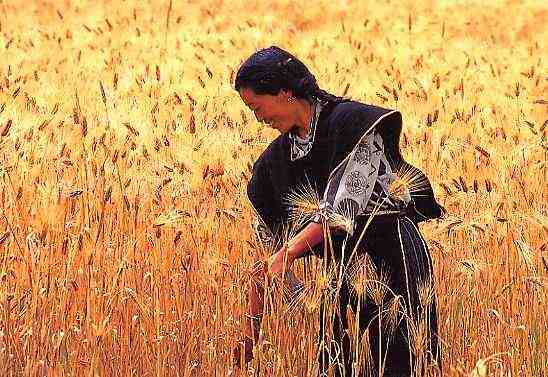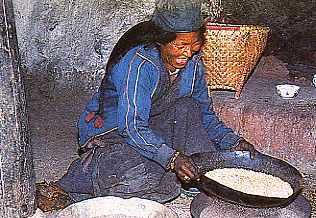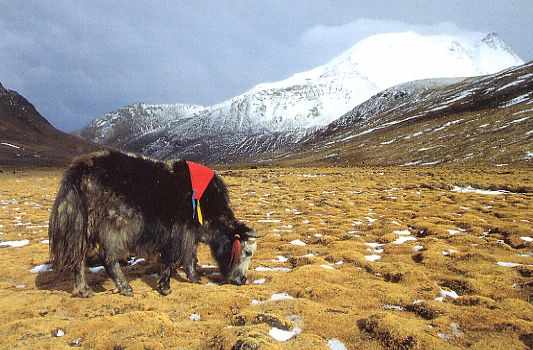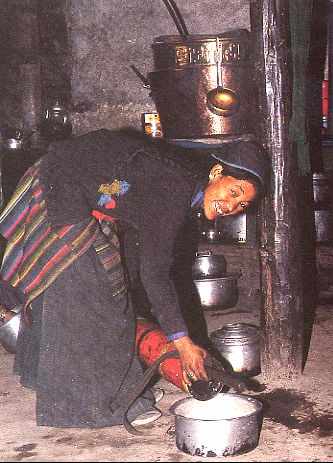|
in order to
understand as Europeans the simple rules of correct feeding
of the Do Khyi, one should have knowledge of the food in Tibet.
It is
so simple!
Barley
Still mainly in Tibet as grain the fast
maturing barley is cultivated (120 days), here a special high land barley
which at values of 3700 m (!) prospers, in very favorable situations also
rice, peas and different leguminous plants.
The barley covers 40 % of the carbohydrate supply in the population
nevertheless.
The barley is made by means of to roast in hot sand, germ-unable and leaves
themselves in such a way make durable for a very long time. The roasted
final product is designated as Tsampa and consists of the whole grain
including the surrounding covering. To Europeans the benefit of Tsampa is
not recommended, after despite sifting the sand out nevertheless rough sand
parts and small little quarry pieces remain in it, it is one would like a
complete dentures reorganization to risk.
|
 |
 |
The high land barley is the
protein-poorest grain places, contains not adhesive and cannot be converted
thus to bread, is however much mineral material and rich in vitamins.
The Tsampa, by the each Tibetan a pouch fully with itself leads grindet and
stirred into soups, Yoghurt however into buttertea in a lump is usually
eaten. This happens predominantly with the fingers (agitate and eat).
Milk and milk products
A majority of the Tibetan high country is
rough, unfruitable grass country, grass-quilts. Here e.g. in the Changtang
or also Amdo humans live as nomads and pull with their cattle, the Tibetan
goats, sheep and over 3000 m., the Yaks over the grass country. The Do Khyi
is the dog of the nomadic hirten.
Primarily humans of milk products live such as yoghurt, cheese and the most
important component of the milk, the butter.
|
 |
A Yakcow gives straight 2 Ltr. milk on the
day, which is a little similar however in its condition of the cow's milk in
our degrees of latitude. The milk of the Yak is extremely fat content (up to
65% fat). Similarly to that also the fat content of sheep and goat milk, the
milk production behaves is just as small however very fat content. The
protein content (milk protein) is lower.
The butter of the Yakmilk becomes related burning the butter lamps, the skin
care and for the buttertea of the Tibetans.
Without the high fat content in the nutrition surviving would not be
possible in this rough climate.
Buttertea
The Tibetan people prefers the brick tea
made of China, prefers these due to its strong taste to the Indian one.
Contained very many mineral materials and also vitamine, with the tea sheets
long time is cooked for this fermented tea and shifted with the greasy
Yakbutter. Generally a boiler is to be found fully butter tea, this becomes
with salt and soda in each tent or house. The taste reminds of cream soup (if
the Yakbutter is not rancid). Buttertea contains all for the human nutrition
substantial mineral materials and vitamine, together with Tsampa is it a
staple food.
Meat
Despite the nomadic way of life meat is
not a main part in the nutrition. The faithful Tibetan will not slaughter an
animal, in addition he needs around-pulling Mohammedans. Usually only one
mark is slaughtered in the year to a high holiday.
The meat is cut dried predominantly in strips and kept grindet if necessary.
The nutrition of the DO Khyi and dogs
Due to the nutrition of humans described
above it becomes clearly evident that the dog is generally very protein-poor
nourished with the Tibetans - like evenly humans also (Hans Foerst speaks
rightfully with the human nutrition of one `Diaet`).
The dog is fed straight with the nomads well and receives Tsampa with sheep
or goat milk.
This means little protein, good fat and mineral material content, as well as
all necessary vitamines. This means however at the same time a high ballast
material content by the admixture of grain bowls and sand.
Meat is in the nutrition of the dogs a secondary matter, if these cannot do
itself such by the catch of insects or mice grab themselves. The unique meat
waste gifts at battle days in the year play a supporting part.
Tibetan nutrition of the dogs convert on
Europe
Traditionally our dogs in the west were
nourished until before approx. 100 years likewise with little meat, for it
however the more from " kitchen wastes ". The European nourished himself
however always already more protein-rich than a Tibetan.
The protein portion in our nutrition rose in the today's time extremely,
that during our dog nutrition also!
|
 |
A Do Khyi will not in the long term stand
this nutrition with up to 65% raw protein (damp fodder), its entire
metabolism is to the nutrition with little protein however high in vitamines
and mineral material content, with very high portion of ballast materials
adapted.
In this way a quite substantial dog can develop despite such " meager Diaet
".
It applies to avoid thus high protein contents with finished fodder as also
even prepared. This already with the puppy and growing up dog. Milk products
are only in the " sour " preparation as yogurt, if necessary. To recommend
cheese or quark, this however nevertheless moderately, after the milk
protein content of the cow's milk is substantially higher
A good manufacture skirt fodder with
maximally 23% raw protein, as well as a high portion of essential fatty
acids and ballast materials is recommended this already with the raising of
puppy. Do Khyi love alternation and are pleased quite over prepared fodder
in the special from barley pellet and buckwheat with small portions of meat.
Thistle or olive oil should not be missing here. To recommend would be still
for this the gift of oats or wheat bran.
Consequences of error feeding
In particular the too protein contents
nutrition from " puppy/young dog finished fodder Large Breed " in connection
with high vitamin E and calcium content provides for a too rapidly growing
skeleton, with which the young Do Khyi gets joint problems and thus pain
when running.
Likewise the digesting system cannot the
protein materials correctly diminish and it form " fermentation arrears " in
the intestine, which damage the entire digesting system in the long term
irreparably, equally suffers oneself the metabolism, in particular the
organs taken part in the digesting system such as liver and kidney, as well
as the skin under it.
The Do Khyi becomes thus ill and surely not particularly old thereby! It is
nourished rather simply to be nourished a Do Khyi correctly. After it is a
very good fodder-worth might thus the gift one particularly on it cut fodder,
which the breeder does recommend in the long term probably also not to
expensive its.
Ruth Reheuser
07/2001
Source of picture: Mustang the
mysterious Kingdom of, Mira publishing house
|
![]()